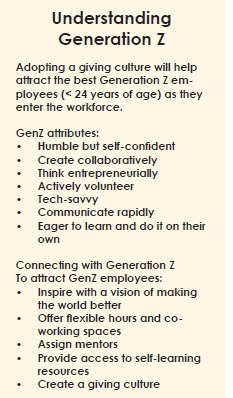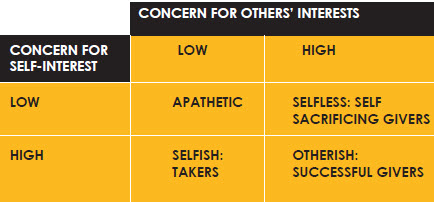Harnessing the Gen Z Innovators

Three Steps to Creating a Giving Culture
Every business is being transformed by technology at an accelerating rate. Is the culture of the company evolving in response to this new reality? Is the company ready to harness the significant value that the youngest generation of professionals, entrepreneurial Generation Z (< age 24), will bring as they enter the workforce?
…[Gen Z] is by far the most tech savvy, connected and self-educated group. While Gen Y is known for ‘side gigs’ and having multiple careers, Gen Z is more focused on working for themselves.”
–Dan Schawbel, Millennial Branding, Entrepreneur, February 3, 2014
As the pace of innovation accelerates, companies unable to change risk falling behind more agile competitors. The thinking of age 50+ leaders (including the author) may be bound by the realities that existed during most of their lifetime. Adding Gen Z workers who have grown up in the digital world offers a path for companies to keep moving forward.
In contrast to the Gen Y “Millennial” stereotype – overconfident, narcissistic, entitled – research finds Gen Z overall to be “educated, industrious, collaborative and eager to build a better planet,” according to Anne Kingston. Humble yet self-confident, they are eager to learn and volunteer. They create collaboratively, think entrepreneurially, and are very tech savvy. Above all, they are well equipped to contribute the unbounded thinking needed to leverage the new digital reality.
Givers advance the world. Takers advance themselves and hold the world back.
–Simon Sinek
What adjustments to company culture can help integrate Gen Z workers into existing enterprises? Organizational psychologist Adam Grant’s study of reciprocity in business over the last ten years may hold the key. In his recent bestselling book, Give and Take: Why Helping Others Drives Our Success, Grant categorizes people into three types with respect to reciprocity: takers, matchers, and givers. While we may use each style in different situations, he discovered that individuals heavily favor one of these three primary styles of interaction. Let’s take a look at these styles, keeping in mind Gen Z’s natural tendencies.
Takers like to get more than they give. Although most of us possess a kind of “justice radar” protecting us from predatory takers, they are good at hiding their true nature. Their Achilles heel is that they can’t help themselves and eventually display evidence of their parasitic nature. Often able to ingratiate themselves to those in a position to help, taker CEOs eventually expose their underlying belief that they are the “suns in their companies’ solar systems.”
Unobtrusive measures of this “all about me” attitude include the size of the CEO’s picture in the annual report, the CEO’s overuse of first person pronouns when describing company progress, and the high degree of compensation they receive. Grant found that taker CEOs average three times as much as the next highest paid executive, while the average differential is 1.5 for givers.
Matchers seek an equal balance of giving and getting. Masters of the quid pro quo, they ”operate on the principle of fairness: when they help others, they protect themselves by seeking reciprocity.” If a CEO continually seeks to create an even exchange of favors, rather than looking for an advantage or not keeping score at all, he/she is a matcher.
In negotiating, you might expect matchers to excel, but Grant’s research discovered that the best negotiators are not matchers. Instead, they are givers: “…the brightest negotiators got better deals for their counterparts.”
Givers prefer to give more than they get. What’s the most common type among successful people? What’s the most common type among unsuccessful people? You may be surprised to learn that “givers” is the answer to both questions.
Grant’s study delineated two types of givers: selfless and other-focused. Selfless givers have “high other-interest and low self-interest… and they pay a price for it. Selfless giving is a form of pathological altruism.” Giving without any getting eventually leads to burnout and disillusionment.
In contrast, other-focused givers are the real winners. “If takers are selfish and failed givers are selfless, successful givers are otherish: they care about benefiting others, but they also have ambitious goals for advancing their own interests.” While they aren’t selfless, winning givers “help with no strings attached; they’re just careful not to overextend themselves along the way.”
Among the appealing attributes of Generation Z (see sidebar), they are natural givers. Also, their ability to use technology makes them a ready source of workers for established non-tech companies that rely on new technologies to a much greater degree than they did a decade ago, not to mention to technology-based enterprises. So how can you develop a giving culture that will encourage bright Gen Z innovators to join your company and help it grow?
established non-tech companies that rely on new technologies to a much greater degree than they did a decade ago, not to mention to technology-based enterprises. So how can you develop a giving culture that will encourage bright Gen Z innovators to join your company and help it grow?
Begin by assessing your style and your team’s. Online self-assessment tools at www.giveandtake.com will rate your company’s current reciprocity practices. Adjusting your own style and leading by example will be critical in achieving organizational change.
Increase your knowledge of Generation Z. Watch TED Talks by Ted Robinson, Adora Svitak, and Logan LaPlante. Read Anne Kingston’s “Get Ready for Generation Z”. Check out books like The Gen Z Effect. Spend time with bright members of GenZ (high school and college age) to learn more about what motivates them.
Review Adam Grant’s book and implement the Humax “reciprocity rings” he describes. Groups of people in your organization meet weekly for 20 minutes. Each individual can make a meaningful request about their professional life, and others in the group use their skills and assets to help fulfill the requests.
Take the lead now in adapting to the new digital reality. Guide employees to create a higher level of giving and trust that will attract Gen Z employees. Incorporate new ideas into the plans, and grow the company!
Every man must decide whether he will walk in the light of creative altruism
or the darkness of destructive selfishness.
-Martin Luther King Jr.
Based in Austin, Texas, Bob Barker is managing partner of 20/20 Outlook LLC. Drawing upon many years’ experience as a senior executive in startups and billion dollar companies, he acts as a trusted advisor, converting CEO vision into executable strategies that accelerate growth.







